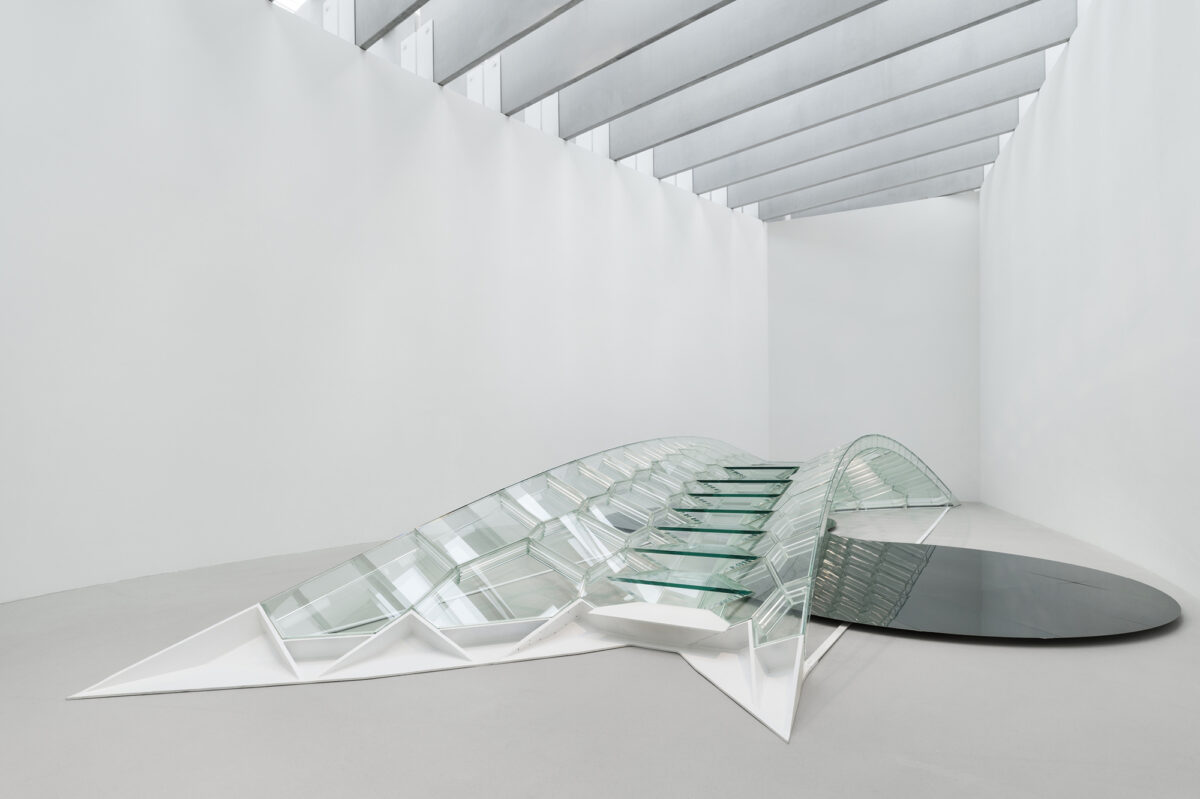
[Image above] Researchers led by University of Pennsylvania architect Masoud Akbarzadeh and research assistant Boyu Xiao defied conventional engineering by constructing a 30-foot-long bridge entirely from 16-millimeter hollow glass units. Their effort is now showcased at the Corning Museum of Glass. Credit: Corning Museum of Glass
If you’ve ever traveled to West Virginia, then you may be familiar with the New River Gorge Bridge—the longest single-span steel arch bridge in the United States. I recently returned from a hiking trip that offered magnificent views of this bridge, which got me thinking about the different types of materials used in structures such as bridges. If steel is up for the challenge, then what about a material like glass?
Most glass bridges take the element of thrill-seeking to new heights by using glass in the bottom part of the bridge, offering views of the landscape directly beneath one’s feet. As of 2022, the longest glass bridge in the world is located in Vietnam. The Bach Long pedestrian glass-bottomed bridge stretches to 632 meters, or 2,073 feet, in length. The previous title for longest glass bridge belonged to China, which is also home to
- The Huangchuan Three Gorges bridge, completed in 2020 (526 meters; 1,726 ft);
- The Hongyagu bridge, completed in 2018 (488 meters; 1,601 ft); and
- The Zhangjiajie Glass Bridge, opened in 2016 (430 meters; 1,411 ft).
In addition to these global glass bridges, there are also a variety of glass skywalk attractions throughout the U.S., such as
- The Grand Canyon Skywalk in Arizona, which extends 70 feet over the rim of the Grand Canyon (opened in 2007);
- The Gatlinburg SkyBridge in Tennessee, which spans over 680 feet and features 30 feet of glass paneling in the middle of the bridge (opened in 2019); and
- The Boyne Mountain Resort SkyBridge in Michigan, which is 118 feet in length and features a glass bottom throughout parts of the walkway (opened in 2022).
Although the transparent aspect of glass makes it appealing to use in architecture, glass typically does not serve in load-bearing capacities due to its known brittleness. Even in glass-bottomed bridges, the glass must be designed in a way that allows for movement and flexibility with each section, so as not to create stress concentrations that could result in shattering.
To avoid any stress-related malfunctions, glass in architecture typically relies on the support of load-bearing materials such as concrete or steel. Glass has successfully been used in applications including curtain walls and flood walls with the support of these load-bearing materials, among other aids.
Glass has been used in some load-bearing capacities with simple geometries, such as stacked glass brick walls. But the curvature in architecture such as bridges places additional stresses on the structure that until now glass alone has not overcome. Researchers at the University of Pennsylvania Weitzman School of Design prevailed over this challenge, however, by designing a 30-foot bridge made entirely of hollow glass units.
The bridge, which was completed in November 2024, first took shape in 2017, when architect and structural engineer Masoud Akbarzadeh started playing around with the concept of using thin sheets of glass to create a “super-efficient structure,” as he called it. From there, the project unfurled into a whole new feat.
According to an article from Penn Today, the design principles behind the bridge stem from ancient engineering and architectural methods that date back to as far as 4000 BCE, when Mesopotamians experimented with building arches and domes. The design also drew on the concept of the funicular curve, an architectural principle. The funicular curve, which is used for compression-only structural forms, determines how an arch is formed through a load distribution of weights hung by a rope. The result is a curved structure formed through compression and tension.
Similarly, the design principles used for the glass bridge are based on a “compression-dominant structural form,” meaning the strength and form of the structure draws on compression from the force of the material against itself.
“All these pieces alone, hollow glass units, might seem quite brittle—and they are,” Akbarzadeh says in the Penn Today article, “but depending on how you design to put these glass units together, they start relying on each other, and the units’ assembly establishes a path for the load to be transferred efficiently. Thus, the bridge gains strength as a whole.”
Each hollow piece of glass used to construct the bridge must fit precisely with the next, allowing only a 0.1-millimeter margin for error. If each piece isn’t fitted with this level of accuracy, the entire structure is subject to collapse. The team of collaborators also used a common resin called polyvinyl butyral to serve as the connecting material between the hollow glass.

Credit: Corning Museum of Glass, YouTube
Despite concerns about transporting the finished structure without compromising its structural integrity, the team at UPenn was able to relocate the glass bridge to the Corning Museum of Glass in New York, where it will stand on display until Sept. 1, 2025.
Akbarzadeh, along with other researchers, recently explored the load-bearing capabilities of glass in conjunction with a special plastic called Surlyn. The researchers found that the glass could withstand more pressure with the added layer of Surlyn, furthering the idea that glass has the potential to be used in more future building applications with the right type of support. The full paper, published in Engineering Structures, can be found here.
Author
Helen Widman
CTT Categories
- Construction
- Glass


